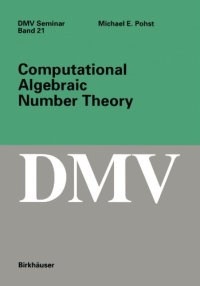
Ebook: Computational Algebraic Number Theory
Author: Michael E. Pohst (auth.)
- Genre: Mathematics // Computational Mathematics
- Tags: Science general
- Series: DMV Seminar 21
- Year: 1993
- Publisher: Birkhäuser Basel
- City: Basel; Boston
- Edition: 1
- Language: English
- djvu
Computational algebraic number theory has been attracting broad interest in the last few years due to its potential applications in coding theory and cryptography. For this reason, the Deutsche Mathematiker Vereinigung initiated an introductory graduate seminar on this topic in Düsseldorf. The lectures given there by the author served as the basis for this book which allows fast access to the state of the art in this area. Special emphasis has been placed on practical algorithms - all developed in the last five years - for the computation of integral bases, the unit group and the class group of arbitrary algebraic number fields. Contents: Introduction • Topics from finite fields • Arithmetic and polynomials • Factorization of polynomials • Topics from the geometry of numbers • Hermite normal form • Lattices • Reduction • Enumeration of lattice points • Algebraic number fields • Introduction • Basic Arithmetic • Computation of an integral basis • Integral closure • Round-Two-Method • Round-Four-Method • Computation of the unit group • Dirichlet's unit theorem and a regulator bound • Two methods for computing r independent units • Fundamental unit computation • Computation of the class group • Ideals and class number • A method for computing the class group • Appendix • The number field sieve • KANT • References • Index
Computational algebraic number theory has been attracting broad interest in the last few years due to its potential applications in coding theory and cryptography. For this reason, the Deutsche Mathematiker Vereinigung initiated an introductory graduate seminar on this topic in Düsseldorf. The lectures given there by the author served as the basis for this book which allows fast access to the state of the art in this area. Special emphasis has been placed on practical algorithms - all developed in the last five years - for the computation of integral bases, the unit group and the class group of arbitrary algebraic number fields.